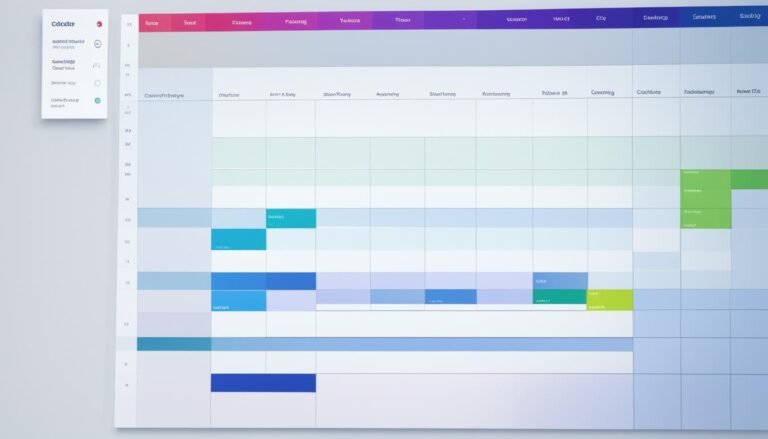Web Analytics: A Comrehensive Guide
Are you ready to dive into the world of web analytics? Get ready to unlock the secrets of your website’s performance and make data-driven decisions with this comprehensive guide.
From understanding key metrics to analyzing user behavior, this article will equip you with the tools and techniques to optimize your online presence.
So, roll up your sleeves and let’s embark on this data-driven journey together.
Let’s turn numbers into actionable insights and take your website to new heights.
Key Takeaways
- Web analytics provides valuable insights and data for informed decision-making.
- Analyzing website traffic, user behavior, and conversion rates helps identify areas for improvement.
- Tracking marketing campaigns allows for effective resource allocation and increased ROI.
- Understanding audience demographics and preferences helps tailor content and offerings.
The Importance of Web Analytics
You shouldn’t underestimate the value and impact of web analytics on your online business. Web analytics provides valuable insights and data that can help you make informed decisions and drive business growth. By analyzing website traffic, user behavior, and conversion rates, you can identify areas for improvement and optimize your online presence.
One of the key benefits of web analytics is the ability to track and measure the effectiveness of your marketing campaigns. With the data provided, you can determine which campaigns are generating the most leads and conversions, allowing you to allocate your resources more effectively. This can lead to increased ROI and overall business growth.
Furthermore, web analytics allows you to understand your audience better. By tracking demographic data, user preferences, and browsing patterns, you can tailor your content and offerings to meet their needs and expectations. This personalized approach can result in higher customer satisfaction and loyalty, ultimately driving business growth.
In addition to these benefits, web analytics also enables you to identify and address website issues. By analyzing user behavior and navigation paths, you can identify areas where users may be encountering difficulties or dropping off. By making necessary improvements and optimizations, you can enhance the user experience and increase conversion rates.
Understanding Key Metrics in Web Analytics
To fully understand the effectiveness of your website and optimize its performance, there are three key metrics you need to focus on:
-
Conversion rate optimization measures the percentage of visitors who take a desired action on your website, such as making a purchase or filling out a form.
-
Bounce rate analysis helps you identify the percentage of visitors who leave your site after viewing only one page.
-
Traffic source analysis allows you to determine which channels are driving the most traffic to your site, helping you allocate resources effectively.
Conversion Rate Optimization
Improving your website’s conversion rate is crucial for maximizing the success of your online business. By optimizing your conversion rate, you can increase the number of visitors who take a desired action, such as making a purchase or signing up for a newsletter. One effective strategy to achieve this is through A/B testing. A/B testing involves creating two versions of a webpage and testing them against each other to determine which one performs better in terms of conversion rate. This allows you to make data-driven decisions based on evidence rather than relying on guesswork. By analyzing the results of A/B tests, you can identify areas for conversion rate improvement and make informed changes to your website that will drive better results.
| A/B Testing Strategies | Benefits | Challenges |
|---|---|---|
| Test different headlines | Determine the most compelling message for your audience | Requires significant traffic to obtain statistically significant results |
| Test different calls-to-action | Find the most effective way to prompt visitors to take action | Can be time-consuming to set up and analyze |
| Test different layouts | Optimize the overall user experience | May require technical expertise to implement accurately |
Incorporating A/B testing strategies into your conversion rate optimization efforts can help you make informed decisions and improve your website’s performance.
Bounce Rate Analysis
When analyzing bounce rate in web analytics, it’s important to look at both the quantity and quality of website traffic. Bounce rate refers to the percentage of visitors who leave a website after viewing only one page. Understanding and analyzing bounce rate can provide valuable insights into user engagement and website performance.
Here are five key points to consider when analyzing bounce rate:
-
Content Relevance: Assess whether the content on your website aligns with the expectations of your target audience.
-
Page Load Speed: Slow loading times can negatively impact user experience and increase bounce rate.
-
Navigation and UX: Ensure that your website is user-friendly, with intuitive navigation and a seamless user experience.
-
Mobile Optimization: With the rise of mobile usage, ensure your website is optimized for mobile devices to avoid high bounce rates.
-
Exit Rate Analysis: Analyze the exit pages to understand where visitors are leaving your website and identify areas for improvement.
Traffic Source Analysis
When analyzing web traffic sources in your analytics, it’s important to understand the key metrics that can provide insights into user behavior and acquisition channels.
Website traffic analysis allows you to determine where your visitors are coming from and how they’re finding your site. By analyzing the different traffic sources, you can gain valuable insights into the effectiveness of your marketing efforts and make data-driven decisions to optimize your acquisition channels.
User behavior analysis, on the other hand, helps you understand how visitors are interacting with your website, such as their browsing patterns, time spent on each page, and conversion rates.
Tools and Platforms for Web Analytics
You can start using various tools and platforms for web analytics right away. These tools and platforms are designed to help you gather data and analyze it effectively to gain valuable insights into your website’s performance.
Here are five popular options that can assist you in your data analysis journey:
-
Google Analytics: This web analytics software is widely used and offers a comprehensive set of features to track and analyze website traffic, user behavior, and conversion rates.
-
Adobe Analytics: Known for its advanced analytics capabilities, Adobe Analytics provides in-depth insights into customer behavior, segmentation, and marketing campaign performance.
-
Hotjar: This tool offers heatmaps, session recordings, and user feedback to help you understand how visitors interact with your website and identify areas for improvement.
-
Mixpanel: Ideal for tracking user actions and events, Mixpanel enables you to analyze user behavior, retention rates, and conversion funnels to optimize your website’s performance.
-
Kissmetrics: Focused on customer behavior analysis, Kissmetrics helps you understand how individuals engage with your website, providing insights to improve user experience and drive conversions.
Setting Up Web Analytics Tracking
To effectively track your website’s performance, it’s crucial to set up web analytics tracking.
By implementing tracking tools, you can gain valuable insights into user behavior, conversion rates, and overall website performance.
Choosing the right tracking tools, such as Google Analytics or Adobe Analytics, is essential for accurate data collection and analysis.
Importance of Tracking
Tracking the performance of your website is crucial for gaining valuable insights into your audience and improving your online presence. By setting up web analytics tracking, you can monitor various metrics that provide a deep understanding of customer engagement and the user journey.
Here are five reasons why tracking is important:
-
Identify popular content: Tracking allows you to see which pages or blog posts attract the most visitors, helping you create more of what your audience wants.
-
Measure conversion rates: Tracking enables you to analyze the effectiveness of your marketing campaigns and identify areas for improvement to increase conversion rates.
-
Track user behavior: By tracking user behavior, you can gain insights into how visitors navigate your website, which can help you optimize the user journey and improve overall user experience.
-
Monitor traffic sources: Tracking helps you understand where your website traffic is coming from, allowing you to focus your efforts on the most effective acquisition channels.
-
Set and measure goals: Tracking allows you to set specific goals for your website, such as increasing newsletter sign-ups or product purchases, and measure your progress towards achieving those goals.
With proper tracking in place, you can make data-driven decisions to enhance your website’s performance and drive better results.
Choosing Tracking Tools
When choosing tracking tools for setting up web analytics tracking, it’s important to consider the specific needs and goals of your website. Customization options play a crucial role in selecting the right tool.
Every website has unique requirements, and having the ability to customize the tracking tool allows you to tailor it to your specific needs. Look for tools that offer flexible tracking options, such as event tracking, goal tracking, and e-commerce tracking.
Additionally, data privacy concerns should be taken into account. Ensure that the tracking tool you choose complies with data protection regulations and provides features like anonymization and data encryption to safeguard user information.
Prioritizing customization options and addressing data privacy concerns will help you select the most suitable tracking tool for your web analytics needs.
Analyzing Website Traffic and User Behavior
Understanding user engagement is crucial for analyzing website traffic and user behavior. By conducting user engagement analysis, you can gain valuable insights into how visitors interact with your website and make data-driven decisions to optimize its performance.
Here are five key areas to consider when analyzing website traffic and user behavior:
-
Bounce Rate: Evaluate the percentage of visitors who leave your website without exploring any further. A high bounce rate may indicate a lack of relevance or usability, leading to potential improvements in content or navigation.
-
Session Duration: Measure the average time users spend on your website. Longer session durations typically indicate higher engagement, while shorter durations may suggest a need for more engaging and compelling content.
-
Page Views: Assess the number of pages viewed per session. Higher page views may indicate visitor interest and engagement, while lower page views could highlight the need to improve website navigation or content discoverability.
-
Conversion Rate: Track the percentage of visitors who complete a desired action, such as making a purchase or submitting a form. Analyzing conversion rates helps identify areas for optimization and potential barriers to conversion.
-
Click Patterns: Examine the areas of your website where users click the most. This analysis can reveal which elements are attracting attention and driving engagement, allowing you to optimize your website layout and design.
Conversion Tracking and Optimization
To effectively optimize your website for conversions, you need to focus on the different stages of the conversion funnel. Conversion tracking and optimization are crucial aspects of web analytics that help you understand how well your website is performing in terms of converting visitors into customers. By analyzing the conversion rate, you can identify areas of improvement and take actionable steps to increase conversions.
Conversion rate analysis allows you to measure the effectiveness of your website in terms of converting visitors. By tracking key metrics such as the number of conversions, conversion rate, and conversion value, you can gain valuable insights into the performance of your website. This data-driven approach helps you identify which pages or elements of your website are underperforming and need optimization.
One key area to focus on when optimizing for conversions is your landing pages. Landing page optimization involves improving the design, layout, and content of your landing pages to maximize conversions. By conducting A/B tests, you can compare different versions of your landing pages and determine which one performs better.
Utilizing Segmentation and Filters in Web Analytics
You can enhance your web analytics by utilizing segmentation and filters to gain valuable insights and make data-driven decisions. Segmentation techniques and filter strategies allow you to break down your website data into meaningful groups, enabling you to analyze specific segments and understand their behaviors.
Here are five ways you can leverage segmentation and filters in web analytics:
-
Visitor segmentation: Divide your website visitors into different groups based on demographics, behavior, or source of traffic. This will help you understand your audience better and tailor your marketing efforts accordingly.
-
Conversion funnel analysis: Use filters to track the conversion journey of your visitors and identify where they drop off. By pinpointing areas of improvement, you can optimize your website and increase conversions.
-
Content analysis: Segment your content by categories or tags and analyze which topics or types of content perform best. This will help you create more targeted and engaging content for your audience.
-
Campaign analysis: Filter your data by specific marketing campaigns to evaluate their effectiveness. By measuring key metrics, such as click-through rates and conversion rates, you can optimize your campaigns for better results.
-
E-commerce analysis: Utilize filters to analyze the purchasing behavior of your customers. By segmenting them based on purchase frequency or average order value, you can identify your most valuable customers and create personalized marketing strategies.
Advanced Techniques in Web Analytics
Once you have mastered the basics of web analytics, you can begin exploring advanced techniques to further optimize your data analysis and drive actionable insights.
Advanced segmentation techniques allow you to dig deeper into your data and gain a more comprehensive understanding of user behavior. By segmenting your audience based on specific criteria such as demographics, geographic location, or user behavior, you can uncover valuable insights that can inform your marketing strategies and website optimization efforts.
Predictive analytics takes web analytics to the next level by using historical data and statistical modeling techniques to make predictions about future user behavior. By analyzing patterns and trends in your data, you can identify potential opportunities or risks and make data-driven decisions to maximize your website’s performance.
To implement advanced segmentation techniques, you can use tools like Google Analytics or other web analytics platforms that offer robust segmentation capabilities. These tools allow you to create custom segments and apply filters to your data, enabling you to analyze specific subsets of your audience and gain insights that are relevant to your business goals.
Predictive analytics, on the other hand, requires more advanced statistical modeling skills and tools. You can use techniques like regression analysis, time series analysis, or machine learning algorithms to uncover patterns and make predictions about future user behavior.
Making Data-Driven Decisions With Web Analytics
By regularly analyzing and interpreting web analytics data, you can make informed and strategic decisions to drive the growth of your website and business. Web analytics provides valuable insights into user behavior, allowing you to understand how visitors interact with your site and identify areas for improvement.
To effectively harness the power of web analytics, consider incorporating the following data visualization techniques and A/B testing strategies:
-
Use interactive dashboards: Visualize your data in a user-friendly and interactive format, allowing you to easily spot trends and patterns. Dashboards provide a comprehensive view of your website’s performance, enabling you to make data-driven decisions quickly.
-
Conduct A/B testing experiments: Test different versions of your website or specific elements to determine which performs better. By comparing metrics such as conversion rates and bounce rates, you can optimize your site to provide the best possible user experience.
-
Utilize heatmaps: Heatmaps visually represent user engagement by showing where visitors click, scroll, and spend the most time on your website. This information helps you identify areas of high engagement and areas that need improvement.
-
Implement funnel analysis: Funnel analysis allows you to track and analyze user behavior throughout the conversion process. By identifying bottlenecks and drop-off points, you can optimize your website to improve conversion rates.
-
Monitor user segmentation: Segmenting your user base allows you to understand the behavior and preferences of different groups. This information can guide your marketing efforts and help you tailor your website to specific target audiences.
Conclusion
In conclusion, web analytics is an indispensable tool for businesses looking to make data-driven decisions and optimize their online presence. By understanding key metrics, setting up tracking, and analyzing user behavior, businesses can gain valuable insights to improve their website’s performance and increase conversions.
With the plethora of tools and platforms available, harnessing the power of web analytics has never been easier. So don’t miss out on this game-changing opportunity to skyrocket your online success and leave your competitors in the dust!






